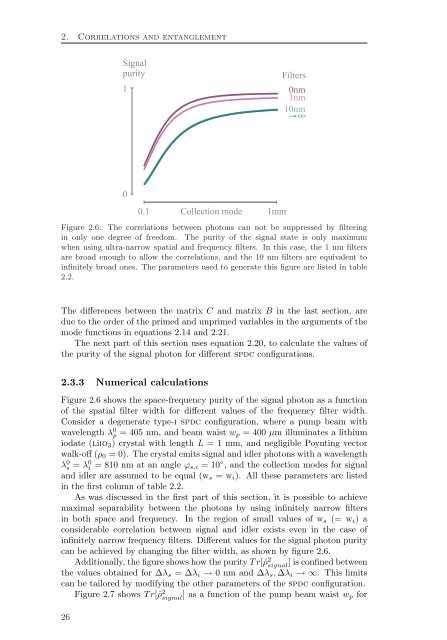Spatial Characterization Of Two-Photon States - GAP-Optique
Spatial Characterization Of Two-Photon States - GAP-Optique
Spatial Characterization Of Two-Photon States - GAP-Optique
Create successful ePaper yourself
Turn your PDF publications into a flip-book with our unique Google optimized e-Paper software.
2. Correlations and entanglement<br />
Signal<br />
purity Filters<br />
1<br />
0<br />
0.1 Collection mode 1mm<br />
0nm<br />
1nm<br />
10nm<br />
→∞<br />
Figure 2.6: The correlations between photons can not be suppressed by filtering<br />
in only one degree of freedom. The purity of the signal state is only maximum<br />
when using ultra-narrow spatial and frequency filters. In this case, the 1 nm filters<br />
are broad enough to allow the correlations, and the 10 nm filters are equivalent to<br />
infinitely broad ones. The parameters used to generate this figure are listed in table<br />
2.2.<br />
The differences between the matrix C and matrix B in the last section, are<br />
due to the order of the primed and unprimed variables in the arguments of the<br />
mode functions in equations 2.14 and 2.21.<br />
The next part of this section uses equation 2.20, to calculate the values of<br />
the purity of the signal photon for different spdc configurations.<br />
2.3.3 Numerical calculations<br />
Figure 2.6 shows the space-frequency purity of the signal photon as a function<br />
of the spatial filter width for different values of the frequency filter width.<br />
Consider a degenerate type-i spdc configuration, where a pump beam with<br />
wavelength λ 0 p = 405 nm, and beam waist wp = 400 µm illuminates a lithium<br />
iodate (liio3) crystal with length L = 1 mm, and negligible Poynting vector<br />
walk-off (ρ0 = 0). The crystal emits signal and idler photons with a wavelength<br />
λ 0 s = λ 0 i = 810 nm at an angle ϕs,i = 10 ◦ , and the collection modes for signal<br />
and idler are assumed to be equal (ws = wi). All these parameters are listed<br />
in the first column of table 2.2.<br />
As was discussed in the first part of this section, it is possible to achieve<br />
maximal separability between the photons by using infinitely narrow filters<br />
in both space and frequency. In the region of small values of ws (= wi) a<br />
considerable correlation between signal and idler exists even in the case of<br />
infinitely narrow frequency filters. Different values for the signal photon purity<br />
can be achieved by changing the filter width, as shown by figure 2.6.<br />
Additionally, the figure shows how the purity T r[ˆρ 2 signal ] is confined between<br />
the values obtained for ∆λs = ∆λi → 0 nm and ∆λs, ∆λi → ∞. This limits<br />
can be tailored by modifying the other parameters of the spdc configuration.<br />
Figure 2.7 shows T r[ˆρ 2 signal ] as a function of the pump beam waist wp for<br />
26



